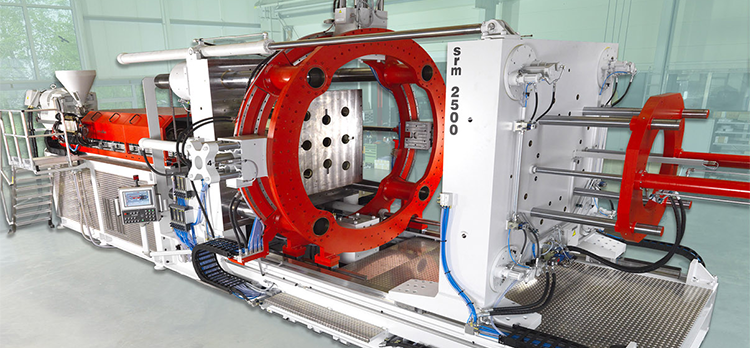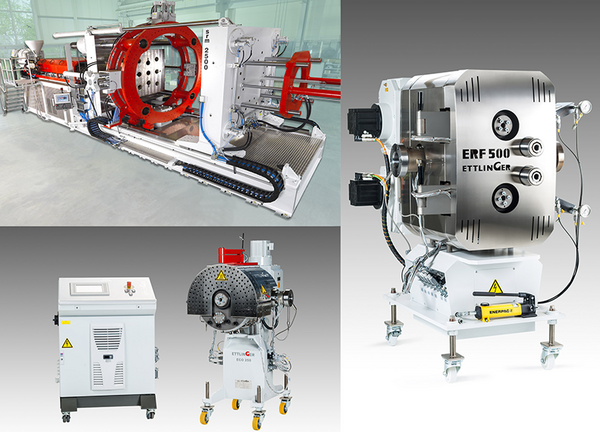Maximum filtration, minimal melt loss
The patented, continuously operating ERF and ECO melt filters can be incorporated into almost any extrusion line. At the heart of both filter types is a rotating filter drum with conical perforations through which the contaminated melt flows from the outside to the inside. A scraper continuously removes the contaminants that are held back at the surface of the drum and feeds them to an exit screw. This enables the filter to be used continuously and fully automatically over a period of weeks and months without having to replace the screen. The advantages of this design are the constant melt pressure, extremely low melt losses, good mixing and homogenizing of the melts and short contaminant residence times on the filter surface.
- ERF filters, for throughputs of up to 6,000 kg/h, are suitable for separating contaminants such as paper, aluminum, wood, silicones or high-viscosity plastics from heavily contaminated polyolefins and polystyrenes. Improvements made to the flow channels now lead to lower differential pressures, which in turn can facilitate increases in throughput rates and gains in productivity of up to 15 %. ERF melt filters are chiefly used in the extrusion of PP, HDPE, LDPE, PS and certain engineering thermoplastics such as packaging films, refrigerator and electronic waste, yoghurt cups (web scrap), car bumpers, bottlecaps or pipes and are processed into granulates, sheets, films or profiles.
- ECO melt filters, designed for maximum throughputs of 1,800 kg/h (ECO 200) and more than 3,000 kg/h (ECO 250), respectively, have been optimized by Ettlinger specifically to support sophisticated extrusion processes such as the manufacture of films, sheets and other semi-finished products. They are ideal for filtering polyolefins, PET and PA as well as recycled materials containing up to 1.5% contaminants. Around two-thirds of the ECO melt filters installed to date are used to process PET. 80% of these are being used in the manufacture of thermoforming sheets and packaging tapes made from bottle regrind, the rest in the processing of fines gained from grinding PET bottles, which are primarily reconstituted into high-quality PET pellets. The remaining third are used in the processing of polyolefins. With a share of around 60%, the main application area of these filters is - apart from compounding - in the manufacture of construction sheeting and thermoforming sheets made of virgin material. Here, they help fulfill high demands regarding the surface quality of the sheeting by greatly reducing the number of specks.
Injection molding machines that deliver 160,000 cm3 in one shot
The srm series of large, two-stage injection molding machines covers the clamping force range from 2,000 to 30,000 kN and shot volumes from 5,000 to 160,000 cm3. Designed for making moldings that weigh upward of 1,000 g and have wall thicknesses of 2 mm and more, typical applications include the production of plastic pallets, fittings, manhole and wastewater systems from virgin, reclaimed or recycled material. In all versions of the series, a relatively small extrusion unit plasticizes the material while a separate plunger unit injects the melt into the mold. This enables large shot volumes to be processed with a high melt quality, but using lower clamping forces in the clamping unit. The small size of the units means that they canbe equipped with correspondingly smaller drives that consume up to 60% less energy thansimilar, conventional injection molding machines from competitors. What's more, thecombination of a compact plasticizing unit and a short clamping unit means that the footprintof the machinery, and therefore the amount of production floor space required, is significantlysmaller.
When it comes to transforming highly contaminated melts into large, heavy and yet highqualitymoldings, combining both Ettlinger products – that is, integrating an ERF melt filterdownstream of the plasticizing unit and another upstream of the injection unit of a srmmachine – results in a solution that offers both high productivity and cost efficiency.
Photos: Ettlinger







